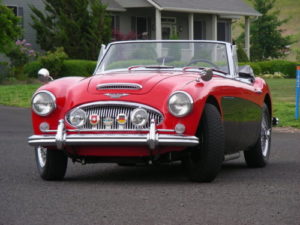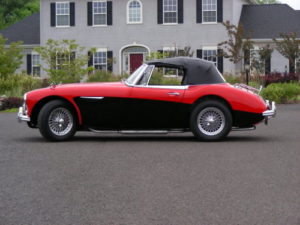A Guest Post by Roy Chaleff
The Austin Healey 3000 is not a nimble car. With a big 3 liter straight six cast-iron engine, a solid rear axle, rear leaf springs, a large diameter steering wheel close to your chest, and a long throw gearbox, it can feel more like a truck, especially when parallel parking where the heavy engine sitting over the front wheels without power-assisted steering provides a strenuous workout. But get it out on the road and it’s a joy to drive. The six-cylinder engine is smooth, puts out plenty of torque (158 ft lbs), and roars with a deep throaty tone. The big Healey is a balanced blend of head-turning good looks, simplicity, and brute strength. It’s a poor man’s Jag.

The later model big Healeys (1965-67) boasts 150 hp, which propels the car from 0-60 mph in just under 10 seconds; certainly not fast by today’s standards, but quite respectable for their day. These cars also have power-assisted brakes (front disc, rear drum) that are very effective. Other refinements of the later years include a wooden dash and increased ground clearance, which although accomplished at some cost to the aerodynamic looks of the earlier models, greatly reduce the rate of loss of exhaust systems.
One of the major drawbacks of the big Healeys was its weak frame. Over bumps or railroad tracks, the car flexes noticeably and, when jacked up at one corner, pinching of the door openings renders the doors inoperable. Apart from its effects on handling, the weak frame presents structural problems that should be a primary concern in purchasing and restoration. Frames tended to rust from the top, where water and salt were trapped between the floor panels and frame, but where the damage wasn’t visible. Sagging, which can be clearly seen as door gaps that are narrower at the top than at the bottom, provides the first warning of frame deterioration. Flexing of the body panels, which follow the frame to which they are attached, produces ripples and eventually cracks from metal fatigue in the fenders and aluminum shroud. Restoring the bodywork over a rotten frame is an expensive mistake that is made all too often. Nor should bodywork be attempted with the engine out of the car, as deflection of the frame under the weight of the engine when it is installed will throw out the alignment of the panels. Fortunately, stronger or reinforced replacement frames are available. The ready availability of spare parts and of superior modern competition components (e.g., light-alloy flywheels, cylinder heads, and engine mechanicals, more efficient carburetors, electronic ignition, alloy wheels, aluminum body panels, disc brake conversions, drilled rotors, and suspension modifications) makes it easy and affordable not only to maintain your car but to upgrade it as well. Thus, the Healey is a vintage car that can be enjoyed not only for its classic lines but that also can be made into a reliable driver or a competitive rallye car.

I took the car out for a drive on a mid-January afternoon. Conditions were favorable, as rain the day before had washed the salt from the roads and the temperature reached well into the 40’s. A task I keep putting off is an adjustment of the choke cable. So I reached beneath the dual carbs and lifted the choke levers manually while my wife (an essential asset for a classic car buff) turned over the engine. The engine started easily enough, but I wore grooves in my fingers holding up the choke levers until the engine was warm enough to run by itself on what little choke adjustment I had in the cable. At the foot of the driveway, I pressed on the brakes and the car pulled sharply to the left. The right brake piston was freezing again, a recurrent problem caused by infrequent use (despite changing the brake fluid annually). I rebuilt the brake calipers a couple of years ago and replaced the standard pistons with ones made of stainless steel, but rust on the inside surface of the caliper bore alone seems sufficient to hang up the piston. One can’t let these cars sit too long or seals dry out and parts rust due to lack of lubrication. Hoping that it would free itself with use, I ventured out, accelerating and then stopping sharply to free the pistons. Lurching along until the car finally stopped true, I wiped the remnants of my partially digested lunch off the windscreen and set off for a short, but enjoyable drive.
Healey engines tend to run hot and, therefore, prefer lower ambient temperatures. The engine was running well and pulling smoothly, and the oil pressure was holding at about 50 lbs (another benefit of low outside temps). I kept the top down and enjoyed the crisp afternoon air. An innovation for which the big Healeys are not given just recognition is the heated front seat. I use the singular here as I refer only to the driver’s side. Despite the heat shield and the extra insulation, I added during restoration, the routing of the exhaust system directly under the driver’s seat provides a sensation akin to sitting naked on a cooktop. This source of heat is comforting on a cold day, but can become rather unpleasant in the summer. But summer seems far away now and there are many cool days of pleasant motoring ahead.
Roy Chaleff is a scientist, author, fine craftsman, and British car enthusiast. None of which prevents him from being an all-around good guy.
There was a nice white Healey 3000 on Barrett Jackson last night. I think it went for around $50K. The 2-tone combination looks nicer on yours though.
Cheers
Greetings, I just ran across your site while searching for Healey sites. That is a beautiful car. Where did you find all of the grille badges?
Mad Morgan
Annapolis, MD